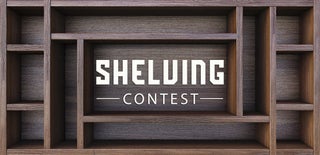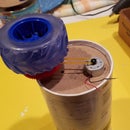Introduction: Angular Knick Knack Shelf
Many shelves are made of 90 degree angles. This is for good reason because 90 degree angles are easier to work with and can store things efficiently. However, I wanted to make a unique and visually interesting piece so I decided to base this shelf on parallelograms with 45 and 135 degree angles.
I also wanted to make an economical piece that didn’t require a lot of wood. So I made it entirely from an 8 foot plank of wood.
The shelf is made of 8 diagonal and 4 horizontal pieces. The diagonal pieces are cut with 45 degree ends parallel to each other. Two of the horizontal pieces are for the top and bottom and are roughly the same size. The top pieces can be a bit longer to have a lip. The 2 center horizontal pieces are half the length of the bottom board.
The diagonals can technically be any size but I recommend them to be 1/3rd the length of the base. So the ratio of diagonals:base:center would be 2:6:3 which can be scaled up. In the shelf I produced, the ratio ended up being more like 5.5:16:8 (which is close) because I had a little less than 8 ft of wood to work with. The top plank on my shelf is about 2 inches longer than the base because I wanted a lip on it.
Supplies
- One wood plank 8 feet long, 6 inches deep, and 1 inch thick.
- Clean workbench or space
- Vices
- Wood glue
- Carpenter's square
- Saw
- I used a jigsaw but any saw or tool that will allow you to make 45 degree cuts can be used
- Tape measure and pencil
- Sand Paper
- I used 220 grit
- Wood filler if needed
- Stain and “rub on” polyurethane (Optional)
Step 1: Marking and Cutting the Wood
Diagonals
- Lay the plank down flat on your work surface
- Use your ruler to mark the distance one inch from the end of the plank Align your carpenter’s square so that it makes a 90 degree angle with the edge of the board and lines up with the mark you made. Draw a line across the plank.
- Cut along the line so that the cut makes a 45 deg cut through the plank as shown in the picture above. [See the following section for notes about the 45 deg bevel cut.]
- Use your ruler to mark the distance 5.5 inches from the cue.
- Repeat steps 3, 4 and 5 until the 8 diagonal pieces have been cut
Horizontals
- Cut off the inch of board which has the 45 degree cut remaining from the last step so the end of the board is flat.
- Make a mark 8 inches down from the end and use a carpenter’s square to make a line across the board.
- Cut straight down along the line.
- Repeat steps 2 and 3 again to make the two middle horizontal pieces.
- Follow the same procedure except with 16 inch measurements to make the top and bottom boards of the shelf (the top board can be longer to make a lip)
Step 2: Notes About Cutting the Wood
For this project I used a jigsaw which could be tilted from the base plate at any angle from flat to 45. The lines I cut were not straight which made it difficult to place the diagonals but it worked out.
So unless you can cut straight lines with a jigsaw I would recommend using a different tool such as a miter saw or table saw. For a table saw you can check out https://woodworking.stackexchange.com/questions/3... for how to make 45 degree bevel cuts.
Miter saws and circular saws can also make 45 degree bevel cuts but you may face the same issues.
When using a jigsaw you want to have the wood clamped down with clamps or a vice and/or have someone there to help because you should have both hands free to maneuver the saw.
Step 3: Gluing the Wood
I recommend laying down the pieces in their respective places as if the shelf was sideways.
Place protective material underneath the pieces so that you don’t get glue on your work surface.
You can glue in stages by starting with the base and 4 diagonals and then adding the two center horizontals and finally the 4 top diagonals and top plank. Or just go crazy and do everything at once.
It was a challenge to make 45 degree cuts for a beginner like me. The cuts shown in the image are not straight at all and this is why the wood pieces are not flush against each other.
Be sure to clean up any excess glue with a damp cloth and be aware that the glue may slide down and pool a little on the surface below since it is sideways.
Step 4: Finishing Touches
Fill in any gaps with stainable wood putty - if the cuts were done flush there shouldn't be a need for this.
Sand down any sharp corners and edges. I used a 220 grit sandpaper.
The image shows the shelf after one coat of a mahogany finish and the rub on polyurethane, for reference in case you decide to do something similar.
A back can be added to the shelf if you want, this should be done after the fact so you can just trace the shelf onto a wood sheet and then cut it and attach.

Participated in the
Shelving Contest









